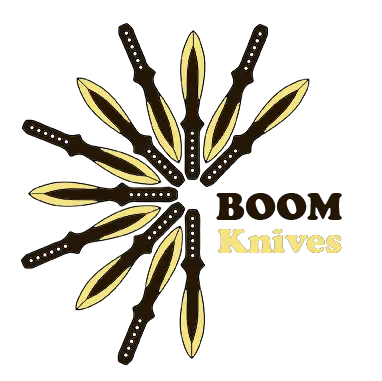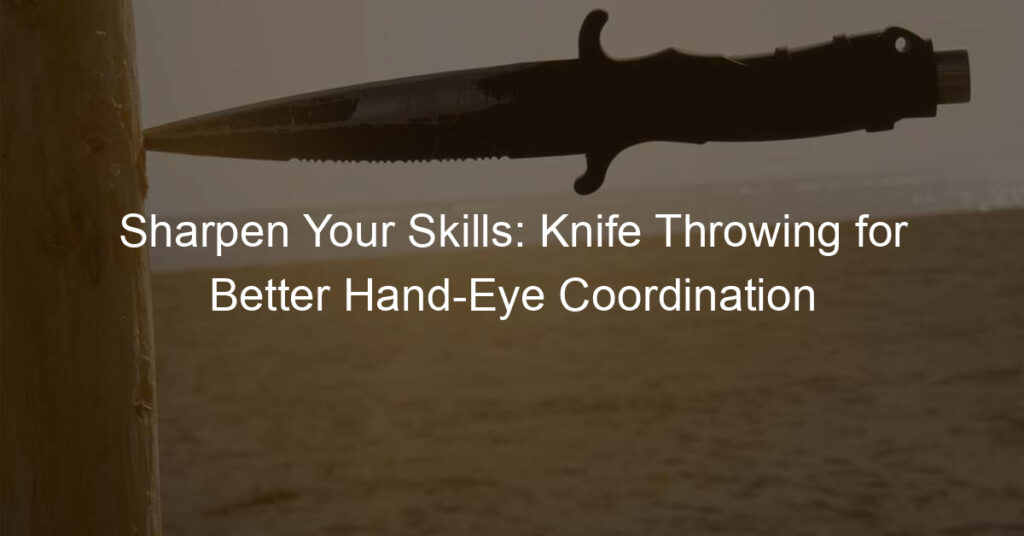Introduction to Knife Throwing
An exciting and challenging sport that requires precision, focus, and discipline. In this article, we will delve into the history of knife throwing, the importance of precision in this sport, and provide an overview of what you can expect from the rest of this article.
-
- History of Knife Throwing
It dates back to prehistoric times when early humans used thrown knives as hunting tools. Over time, knife throwing evolved into a form of entertainment and sport. In the Middle Ages, it was a popular pastime at fairs and festivals. Today, knife throwing is a recognized sport with competitions held worldwide. For more detailed information, you can visit the Wikipedia page on Knife Throwing.
-
- Importance of Precision in Knife Throwing
It’s not just about throwing a knife and hoping it sticks. It’s about hitting your target accurately and consistently. Precision in knife throwing involves a combination of factors, including the correct grip, stance, and throwing technique. It’s a skill that takes time and practice to master, but once achieved, it can be incredibly satisfying.
-
- Overview of the Article
In this article, we will guide you through the basics of knife throwing, delve into precision knife throwing techniques, and provide tips from professional knife throwers. We will also share some useful tips to help you improve your knife throwing skills. By the end of this article, you should have a good understanding of the art of knife throwing and be ready to start your journey towards mastering this fascinating sport.
Basics of Knife Throwing
Understanding the Knife
-
- Different Types of Throwing Knives
The blade-heavy, the handle-heavy, and the balanced knife. The blade-heavy knife is easier to throw from the handle and is ideal for beginners. The handle-heavy knife, on the other hand, is thrown from the blade. The balanced knife, as the name suggests, has an equal weight distribution and can be thrown from either the blade or the handle.
-
- Parts of a Throwing Knife
The blade is the sharp part used for hitting the target. The handle is where you grip the knife. Some throwing knives also have a third part called the tang, which is the part of the blade that extends into the handle.
Plan to use, and personal preference. Beginners should start with a blade-heavy knife as it’s easier to handle. As you progress, you can experiment with handle-heavy and balanced knives. The knife should feel comfortable in your hand and be of the right weight. Too light, and it may not reach the target; too heavy, and it may be difficult to throw.
Knife Throwing Techniques
-
- The Grip
It’s how you hold the knife. The most common grip is the hammer grip, where you hold the knife like you would a hammer, with your fingers wrapped around the handle and your thumb resting on the top. This grip provides control and stability. For more information about grips, visit Wikipedia.
-
- The Stance
Stand with your feet shoulder-width apart, with your non-throwing foot slightly forward. Keep your body straight and relaxed. This stance provides balance and allows for a powerful throw.
-
- The Throw
Bring your arm back, keeping your elbow straight, and then swiftly bring it forward, releasing the knife at the same level as your target. The key is to throw the knife, not push it. It’s all about precision, not power.
-
- Recovery and Repeat
After the throw, it’s time to recover and repeat. Retrieve your knife, reassess your stance and grip, and throw again. Practice is key in mastering knife throwing.
Precision Knife Throwing
Motion in Knife Throwing
-
- Understanding the physics of knife throwing
The physics of knife throwing involves the principles of rotation and gravity. When you throw a knife, it rotates in the air before hitting the target. The speed and angle of your throw determine how many times the knife will rotate before it reaches the target. Understanding these principles can help you improve your precision in knife throwing. For more detailed information about the physics of knife throwing, you can visit this Wikipedia page.
-
- Importance of consistent motion
The more consistent your throwing motion, the more predictable the knife’s flight path and the more accurate your throws will be. This means practicing the same grip, stance, and throwing motion every time.
-
- Exercises to improve motion
These include practicing your grip, working on your throwing stance, and repeating your throwing motion until it becomes second nature. One simple exercise is to practice throwing at a close target until you can consistently hit it, then gradually increase the distance as your accuracy improves.
Knife Throwing Accuracy
-
- Targeting Techniques
It involves visualizing the target and aligning your throw accordingly. A common technique is to focus on a specific point on the target, rather than the entire target. This helps in achieving a more precise throw. For beginners, it’s recommended to start with larger targets and gradually move to smaller ones as their skills improve.
-
- Improving Accuracy Over Time
One effective method is to maintain a throwing routine, practicing regularly at the same distance and with the same type of knife. This helps in developing muscle memory, which is crucial for accuracy. Additionally, keeping a record of your throws can help in identifying areas of improvement and tracking progress over time.
-
- Common Mistakes Affecting Accuracy
These include inconsistent throwing motion, improper grip, and lack of focus on the target. Inconsistent throwing motion can be corrected by practicing the same throwing technique repeatedly. Improper grip can be fixed by experimenting with different grips and choosing the one that feels most comfortable and natural. Lastly, maintaining focus on the target, rather than on the knife or the throwing motion, can significantly improve accuracy.
Professional Knife Throwing
Knife Throwing Training
- Training routines for beginners:Start with a light knife, and practice throwing at a close, large target. Aim to throw the knife so that it makes one complete rotation before hitting the target. Practice this routine regularly, gradually increasing the distance as you become more comfortable. Wikipedia has a comprehensive guide on beginner knife throwing techniques.
- Advanced training routines:This involves practicing with different types of knives and at varying distances. Try throwing from different positions and angles to enhance your adaptability. Participating in professional competitions can also provide valuable experience and feedback.
- Importance of regular practice:It helps to develop muscle memory, which is crucial for achieving consistent throws. Regular practice also allows you to identify and correct any flaws in your technique. Aim to practice a little every day, rather than a lot once a week. This will lead to steady improvement over time.
Knife Throwing Skills
-
- Essential Skills for Professional Knife Throwers
Include accuracy, consistency, and the ability to adjust to different distances and targets. It’s also important to have a good understanding of the physics of knife throwing, such as the rotation of the knife and the effect of wind and other environmental factors. Wikipedia provides a good overview of these principles.
-
- Developing a Unique Throwing Style
Could be a particular grip, a unique stance, or a distinctive throwing motion. Developing your own style not only makes you more memorable, but it can also give you a competitive edge. Developing a unique style is to experiment and practice regularly.
-
- Participating in Competitions
A great way to test your skills, meet other enthusiasts, and gain recognition in the knife throwing community. There are local, national, and international competitions that cater to all skill levels. Participating in these events can provide valuable experience and can also be a lot of fun.
Knife Throwing Tips
-
- Safety Tips
Always ensure that your throwing area is clear of people and pets. Make sure the target is sturdy and won’t allow the knife to bounce back. Always handle the knife by the handle, not the blade. Never throw a knife at a person or animal. Wikipedia has more information on knife throwing safety.
-
- Tips for Improving Precision
Start by standing closer to the target and gradually increase your distance as your accuracy improves. Maintain a consistent grip and throwing motion. Keep your eye on the target and release the knife at the same point in your throw each time. This will help you develop a consistent throwing pattern and improve your accuracy.
-
- Tips for Maintaining Your Throwing Knives
Clean your knives after each use to prevent rust and corrosion. Sharpen them regularly to ensure they maintain their edge. Store them in a dry, cool place to prevent damage from moisture and heat. And always handle them with care to avoid unnecessary wear and tear.
Conclusion: Mastering the Art of Knife Throwing
-
- Recap of key takeaways
We started with the basics of knife throwing, understanding the importance of choosing the right knife and the correct stance. We then moved on to precision knife throwing, where we learned about the significance of focus and accuracy. We also discussed professional knife throwing and shared some valuable tips to enhance your skills. Knife throwing is not just about physical strength, but also about mental fortitude and precision.
-
- Encouragement for continued practice
The more you practice, the better you will become. Don’t be discouraged if you don’t hit the target every time. Even the best knife throwers had to start somewhere. Keep practicing, stay focused, and you’ll see improvement over time. Your journey to mastering knife throwing is just beginning.
-
- Final thoughts on the art of knife throwing
Knife throwing is an art, a sport, and a skill that requires discipline and dedication. It’s a journey of self-improvement and focus. It’s not just about throwing a knife; it’s about understanding the physics, improving your concentration, and learning to control your strength. Keep practicing, stay patient, and you’ll master this fascinating art.







